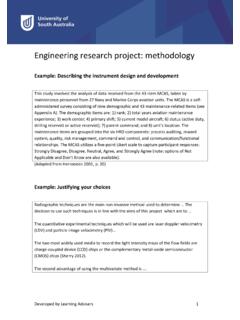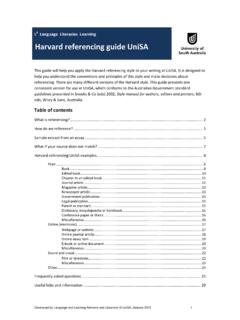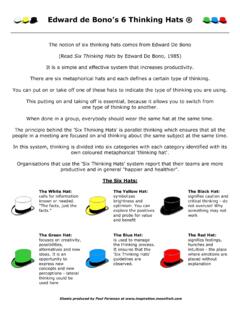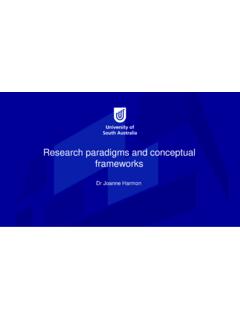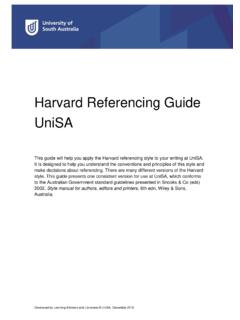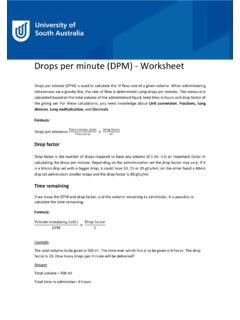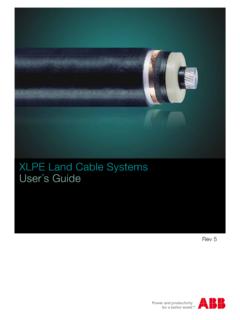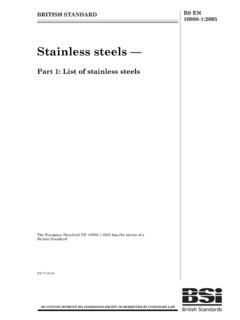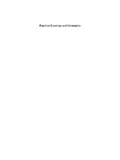Transcription of Report Writing Style Guide for Engineering Students
1 University of South Australia Division of Information Technology, Engineering and the Environment School of Natural and Built Environments Report Writing Style Guide for Engineering Students 4th edition by Anne Winckel and Bonnie Hart revised and updated by Monica Behrend and Bev Kokkinn Prepared in association with Engineering staff and Students , and the Flexible Learning Centre, University of South Australia Sponsored by the University of South Australia Foundation Inc June 2002. Major revisions in the fourth edition: inclusion of a section of Writing a section updating of the Referencing section Major revisions in the third edition: inclusion of examples of electronic referencing additions to Appendix D, Punctuation in technical Writing inclusion of examples in Appendix G, Purposes of paragraphs Major revisions in the second edition included: addition of an index variation to the headings for lists of Figures, Tables and Symbols addition of a table on the Report Writing process and related resources ( table 1).
2 Addition of a section on Starting Writing (section ). inclusion of all referencing examples in section 4 instead of the appendices addition of new diagrams (Figs 10 13) to illustrate the elements involved in a reference list 1996 Anne Winckel and Bonnie Hart First published January 1995. Second edition published August 1995. Third edition published March 1996. Fourth edition published July 2002. Jointly published by the Division of Engineering , Information Technology and the Environment, at the University of South Australia, Mawson Lakes campus, Mawson Lakes, SA 5095. All rights reserved. No part of this publication may be reproduced or transmitted in any form or by any means, electronic or mechanical, including photocopying, recording, storage in an information retrieval system, or otherwise, without prior written permission of the publisher.
3 ISBN 0 86803 149 6. Production acknowledgments Desktop production Anne Winckel and Bonnie Hart Editorial assistance Barbara Brougham Abstract Students need to develop the skills associated with Report Writing to communicate appropriately at University and to fulfil the obligations of their future employment. The provision of this Report Writing Style Guide for Engineering Students is to assist Students in developing these Writing skills. The initial project was funded by the University of South Australia Foundation Inc, the Faculty of Engineering and the Flexible Learning Centre (formerly the Centre for University Teaching and Learning). at the University of South Australia.
4 Learning Advisers, Engineering Staff and personnel from other units collaborated to produce this document which is written in the form of a model Report . The Style Guide specifically deals with: formatting guidelines, components of a Report , Writing a section, referencing of sources, and the technical language appropriate to a quality Report . Style is often a matter of personal preference. Report Writing styles will sometimes differ according to the purpose of the Report and the requirements of a particular school, employer or publisher. It is recommended that particular attention be given to visual impact and readability;. referencing of sources; proofreading and editing; and that the selection of Style be consistent and appropriate to both audience and purpose.
5 I Disclaimer We declare the following to be our own work, unless otherwise referenced, as defined by the University's policy on plagiarism. Anne Winckel Bonnie Hart Monica Behrend ii Acknowledgments Thanks are extended to the University of South Australia Foundation Inc and the Faculty of Engineering for providing project funding. Thanks are also extended to the Flexible Learning Centre (formerly the Centre for University Teaching and Learning). for providing funding and for releasing Anne Winckel and Bonnie Hart, Study Advisers, to form the project team responsible for coordinating and Writing this Report Writing Style Guide for Engineering Students . The writers would like to thank the Dean of Engineering , Professor Eric Hobson, for his ongoing support and endorsement of this project, as well as the many academic staff from the Faculty of Engineering who contributed their ideas, expertise and advice.
6 Thanks are extended to those who acted as a reference group, and to others who willingly contributed. We would also like to acknowledge the staff members who provided specific school-related Report Writing documents, and the many Students who provided feedback for this edition. University of South Australia Engineering staff reference group members: Dr Kazem Abhary Manufacturing and Mechanical Mr Don Cameron Civil Mr Justin Cole Building and Planning Dr Tim Ferris Electronic Mr Oz Gol Electrical Mr David Hands Manufacturing and Mechanical Professor Eric Hobson Dean of Engineering Mr Ray Newell Gartrell School Dr Keith Notley Gartrell School Dr Brian Roberts Gartrell School Mr Bruce Thomas Computer Systems Dr Richard Thorn Electronic Dr Bob Wiltshire Gartrell School Others consulted.
7 Mr Bob Allen Institution of Engineers, Australia Ms Monica Behrend Flexible Learning Centre Mr Ian Charlesworth School of Applied Physics Ms Karen Disney Kinhill Engineers Pty Ltd Ms Tania Giraldi Library, Levels Campus Mr Roger Hadgraft Civil Engineering , Monash University Dr Mohamed Hadi Civil Engineering Ms Margaret Hicks Language and Learning, Flinders University Ms Helen Johnston Flexible Learning Centre Ms Cathy Mahar Library, Levels Campus Dr Graham Nathan Mechanical Engineering , University of Adelaide Ms Leonie Porter Distance Education Centre Prof Stephen Priest Gartrell School Mr Alan Reid Flexible Learning Centre Mr Tony Roberts Centre for Professional Communication Ms Pam Ronan Techsearch Ms Lidia Rozman-Jones Women in Non-traditional Studies, E O Unit iii Dr Paul Skrebels Centre for Professional Communication Ms Ruth Trigg Centre for Professional Communication Ms Sue Tyerman Computer Information Science iv v Contents 1 Introduction 1.
8 Project reports 2. Other uses of the Style Guide 2. 2 Formatting guidelines 3. Format of pages 3. Paper and margins 3. Page numbering 3. Headers and footers 3. Format of type and headings 3. Font 3. Size and Style of type 4. Headings 4. Decimal numbering system 5. Format of text 5. Justification 5. Line spacing 5. Indentation and centring 5. Figures and tables 6. Quotations 6. Equations and formulae 6. 3 Components of a Report 7. Preliminary pages 7. Title page 8. Disclaimer 8. Abstract 9. Acknowledgments 9. Contents 9. Figures 10. Tables 10. Symbols 10. Text of Report 10. Introduction 11. Main sections 11. Conclusion 12. vi Recommendations 13. References 13. Appendices 13.
9 4 Writing a section of a Report 18. Planning 18. Brainstorming 18. Mind mapping 19. Developing a contents page 19. 5 Referencing of sources and originality 20. Two systems of referencing 22. Choosing between referencing systems 22. Consistency in referencing 22. Author-date referencing (Harvard system) 23. In-text author and date 23. Alphabetical reference list 24. Numerical referencing (endnote system) 28. In-text numbers 28. Numbered reference list 30. 6 Technical language 33. Starting Writing 33. Structuring Writing 33. Logical sections 34. Cohesive paragraphs 34. Clear sentences 35. Structuring sentences 35. Proximity of detail and item 35. Series of nouns 35. Parallel construction 35.
10 Grammar 36. Active and passive voice 36. Tense of verbs 36. Agreement between noun and number 37. Agreement between subject and verb 37. vii Vocabulary 38. Personal language 38. Gender inclusive language 38. Jargon and slang 38. Repetition of words 39. 7 Conclusion 40. 8 Recommendations 40. 9 References 41. Appendix A National Competency Standards for Professional Engineers 42. Appendix B Model title page 43. Appendix C Plagiarism: Academic Misconduct Policy 45. Appendix D Punctuation in technical Writing 46. Appendix E Summary of elements in reference lists 49. Appendix F Library resources and Report Writing texts 50. Appendix G Purposes of paragraphs 52. Appendix H Report Writing checklist 53.
